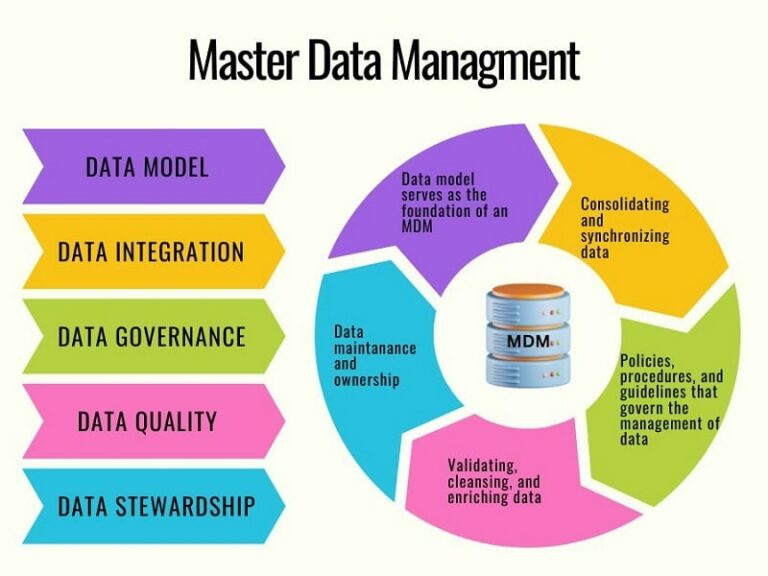Implementing Data Integration in Cloud Environments
In today’s data-driven world, businesses are constantly seeking ways to efficiently manage and analyse information from many different sources.
With the growing popularity of cloud technology, many companies are exploring cloud-based solutions for their data integration needs.
In this article, we will discuss the importance of data integration in cloud environments and provide best practices for its implementation.
We will also examine the advantages of cloud-based data integration, such as improved scalability, flexibility, and cost savings, and how these factors can positively impact businesses.
Additionally, we will cover the essential best practices for implementing cloud-based data integration, focusing on techniques that promote efficient and secure data management across different platforms and systems.
Finally, we will discuss a range of tools and technologies that can help organisations achieve smooth data integration in the cloud.
By providing an in-depth understanding of the benefits and best practices of cloud-based data integration, this article aims to serve as a helpful resource for businesses looking to enhance their data management processes and make the most of their data assets in an ever-evolving digital world.
The Rise of Cloud-Based Data Integration
In recent years, cloud-based data integration has gained significant traction and emerged as a preferred choice for many businesses. This trend is attributed to several factors, including the growing adoption of cloud services, the need for scalable data integration solutions, and the numerous benefits offered by these solutions.
One of the primary reasons behind the increasing popularity of data integration in cloud environments is the widespread adoption of those services by businesses of all sizes.
Companies are increasingly migrating their applications, infrastructure, and data to the cloud to capitalize on the cost savings, flexibility, and scalability that these services offer.
As a result, integrating data across various cloud platforms and on-premises systems has become a critical requirement for businesses seeking to make the most of their cloud investments.
Talking with experience: our three latest clients required us to migrate the legacy data warehouse to Azure Synapse with Azure Data Factory as the integration platform.
Another driving force behind the surge in cloud-based data integration is the ever-growing need for scalable solutions that can efficiently handle vast amounts of data from diverse sources.
With the exponential growth of data being generated and collected by businesses, traditional data integration methods are often unable to keep up with the demands for rapid data processing and analysis.
Cloud-based data integration solutions offer the scalability and performance required to handle large data volumes, enabling you to seamlessly integrate data in real-time or near real-time.
Moreover, the benefits of cloud-based data integration have also contributed to its rising popularity.
These benefits involve lower expenses since companies can use the cloud’s pay-as-you-go system.
This helps to prevent big initial costs for equipment and software. Better flexibility allows businesses to easily adjust to changing data needs and grow their integration abilities when required.
Additionally, better teamwork is possible as cloud-based tools help teams cooperate more efficiently by offering a central place for handling data.
Benefits of Cloud-Based Data Integration
Scalability and Flexibility
One of the most significant benefits of cloud-based data integration is its inherent scalability and flexibility.
Cloud-based solutions allow you to easily scale their data integration capabilities in response to fluctuating data volumes and business needs.
The cloud infrastructure can be easily adjusted to handle increased data loads or accommodate new data sources, ensuring that businesses can efficiently adapt to changing requirements without investing in additional hardware or software.
Scalability Example: when you need more processing power add processing units to your plan; when you don’t need them any more remove them and pay less.
Cost-effectiveness
Cloud-based data integration solutions also offer cost advantages over traditional on-premises systems.
By leveraging the cloud’s pay-as-you-go model, organisations can avoid large upfront investments in hardware and software, as well as reduce ongoing maintenance and operational costs.
This approach enables businesses to allocate resources more efficiently, focusing on value-generating activities instead of managing costly infrastructure.
Managing Cost Example: when you run a heavy integration load scale up your plan; scale down on the weekend or at night when you don’t need it
Simplified Maintenance and Management
Another benefit of cloud-based data integration is the simplification of maintenance and management processes.
Cloud providers take on the responsibility of managing the underlying infrastructure, including hardware, software, and network components, ensuring that businesses can focus on their core activities.
This not only reduces the burden on in-house IT teams but also ensures that data integration processes are supported by the latest technology and security updates.
Enhanced Collaboration and Accessibility
Cloud-based data integration solutions provide a centralized platform for data management, allowing teams to collaborate more effectively and access data from anywhere with an internet connection.
This enhanced collaboration and accessibility enable businesses to make better-informed decisions and respond to changing market conditions more swiftly.
Additionally, it promotes a more cohesive approach to data management across different departments, ensuring that everyone is working from the same set of accurate, up-to-date information.

Cloud Data Integration Challenges
While cloud-based data integration offers numerous benefits, it also comes with its fair share of challenges, such as data privacy and security, plus compliance concerns.
Addressing these challenges is critical to ensuring the success of cloud-based data integration projects and maintaining the trust of both customers and stakeholders.
Data Security
Security is a top concern when implementing data integration in cloud environments. Ensuring the confidentiality, integrity, and availability of data is crucial, especially when dealing with sensitive information.
You need to adopt strong encryption methods, implement robust access control mechanisms, and work with cloud providers that have a proven track record of maintaining high-security standards to protect their data from unauthorized access, breaches, and potential data loss.
Privacy
Privacy is another significant challenge in cloud-based data integration. Companies need to ensure that they comply with various privacy regulations and standards, such as the General Data Protection Regulation (GDPR) and the California Consumer Privacy Act (CCPA), which mandate strict measures for the handling of personal data.
Adopting privacy-by-design principles and implementing data anonymization or pseudonymization techniques can help businesses meet their privacy obligations while still enabling effective data integration.

Compliance Concerns
Compliance with industry-specific regulations and standards, such as the Health Insurance Portability and Accountability Act (HIPAA) for healthcare or the Payment Card Industry Data Security Standard (PCI DSS) for financial services, is another challenge that organisations face when implementing cloud-based data integration.
Ensuring compliance requires a thorough understanding of the relevant regulations and the implementation of appropriate security measures, monitoring, and reporting mechanisms.
Best Practices for Cloud Data Integration
To maximise the benefits of cloud-based data integration while addressing the associated challenges, organisations should adopt the following best practices:
Selecting the Right Cloud-Based Data Integration Platform
Choosing the most suitable data integration platform is critical for the success of any cloud-based data integration project.
You should consider factors such as the platform’s ease of use, scalability, compatibility with existing systems, and support for various data sources and formats.
Next, they should evaluate the platform’s security features, compliance capabilities, and vendor reputation to ensure a secure and compliant data integration environment.
Ensuring Data Security and Privacy
Organisations must prioritise data security and privacy when implementing cloud-based data integration.
This involves adopting strong encryption methods for data at rest and in transit, implementing robust access control mechanisms to prevent unauthorized access, and using data masking techniques to protect sensitive information.
Partnering with a cloud service provider that demonstrates a strong commitment to security and privacy can also help ensure the protection of your data.
Leveraging Data Integration Techniques Optimised for Cloud Environments
Utilising data integration techniques specifically designed for cloud environments, such as ELT (Extract, Load, Transform), can improve the efficiency of cloud-based data integration projects.
Unlike traditional ETL (Extract, Transform, Load) processes, ELT leverages the power of cloud-based data processing engines to perform transformations, allowing for faster and more scalable data integration.
Implementing a Hybrid Approach to Data Integration
For organisations with both on-premises and cloud-based data sources, implementing a hybrid approach to data integration can provide the flexibility needed to accommodate diverse data environments.
A hybrid approach enables businesses to leverage the benefits of cloud-based data integration while maintaining on-premises systems where necessary, ensuring seamless data integration across all data sources.
Monitoring Performance and Usage
Regularly monitoring the performance and usage of cloud-based data integration solutions is essential for optimizing resource allocation and controlling costs.
By tracking key performance indicators (KPIs) and analysing usage patterns, you can identify bottlenecks, inefficiencies, and areas for improvement. This information can be used to make data-driven decisions on resource allocation and system configurations, ultimately maximising the return on investment in cloud-based data integration solutions.
Choosing a Cloud Data Integration Platform
Selecting the right data integration platform is crucial for the success of any cloud-based data integration project. A platform that supports cloud-based data integration and aligns with your business requirements can significantly enhance the efficiency, security, and overall success of your data management efforts. I
The Importance of Selecting a Data Integration Platform
A suitable data integration platform plays a critical role in ensuring the smooth functioning of your cloud-based data integration processes.
Some key factors to consider when selecting a platform include:
- Compatibility with existing systems and support for diverse data sources and formats
- Scalability and flexibility to accommodate your organisation’s growth and changing data needs
- Strong security features to protect your data assets
- Compliance capabilities to help you meet regulatory requirements
- A strong vendor reputation and ongoing support for the platform
Popular Cloud Data Integration Platforms
- Microsoft Azure Data Factory. Azure Data Factory is a cloud-based data integration platform that allows you to create, schedule, and orchestrate data workflows in the cloud. It supports a wide range of data sources, including relational, non-relational, structured, and unstructured data. With its robust security features, scalability, and integration with other Azure services, Azure Data Factory is a popular choice for organizations looking to implement cloud-based data integration.
- Google Cloud Data Fusion. Google Cloud Data Fusion is a fully managed data integration platform designed to simplify the process of integrating, preparing, and transforming data from various sources for analysis. It offers a user-friendly, code-free interface for designing and deploying data pipelines, along with a rich set of pre-built connectors for popular data sources. With its support for real-time and batch processing, Data Fusion is well-suited for organizations seeking a flexible and easy-to-use cloud data integration solution.
- AWS. AWS Glue is a fully managed extract, transform, and load (ETL) service that enables you to move and integrate data across various AWS services and on-premises data stores. It automatically discovers and categorizes your data, generates ETL scripts, and allows you to create scalable data pipelines. With its serverless architecture, AWS Glue enables organisations to focus on their data integration tasks without worrying about infrastructure management.
Implementing Data Integration in Cloud – Summary
It is crucial for businesses to carefully evaluate their cloud data integration requirements and choose the right platform and practices to ensure success. It is not an easy task though.
Usually, data integration platforms are huge platforms with an enormous number of features. Selecting one should be based on a few factors like your current infrastructure, development team skillset and platform reputation.
Also, you should consider factors such as compatibility with existing systems, scalability, security features, compliance capabilities, and vendor reputation when selecting a platform.
By doing so, you can overcome the challenges associated with data integration in cloud environments and fully leverage the benefits these solutions offer.
For those interested in diving deeper into specific cloud data integration topics and technologies, we encourage readers to explore other supporting posts and resources.
By staying informed and up-to-date on the latest developments, you can make well-informed decisions and optimise your cloud data integration strategies for long-term success.




